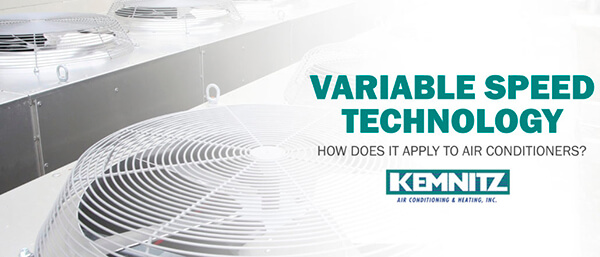The heating and air conditioning industry constantly looks to improve home energy efficiency. Variable speed technology helps homeowners maximize their indoor air experiences. Compared to single-stage and two-stage motors, variable speed technology improves the efficiency of all air conditioners.
What is Variable Speed Technology?
Variable speed technology affects the fan and blower within an air conditioner. Single-stage motors only have “on” and “off” fan settings. Two-stage motors have an intermittent setting for reduced airflow and a wide-open setting. However, variable speed motors provide more control settings, operating between 40% and 100% capacity.
You probably have experienced the abrupt cycles of a single-stage motor. When the air conditioner detects a temperature change, it will run on high until the thermostat registers an adequate temperature drop. Throughout the day, you may feel the room temperature cycle between cold, comfortable, and too warm. A single-stage motor only can turn “on” at maximum capacity and then turn “off.”
A variable speed motor, in contrast, provides the amount of airflow needed to maintain a comfortable temperature. The motor can subtly maintain a comfortable temperature without using its maximum capacity. Therefore, the motor only uses the amount of energy needed at a given time.
Benefits of Variable Speed Technology
Variable speed motors cost slightly more than single-stage or two-stage motors but also offer many benefits that make them more appealing to modern homeowners. Consider some of the reasons why variable speed technology is gaining popularity:
- Efficiency. Since the technology only uses the amount of energy needed at a given time, it does not waste energy like other types of technology. Operational efficiency delivers homeowners two beneficial outcomes: energy expense savings and environmental sustainability.
- Comfortable temperatures. Instead of cycling through various stages of cooling, a variable speed motor will keep a home hovering around the ideal temperature throughout the day.
- Air quality. Variable speed motors tend to run more often at a reduced capacity setting than other types of air conditioners. When the air conditioner runs, it filters and circulates air. With a variable speed unit, you may need to change your air filter more often, but you can breathe easier knowing the system traps higher levels of allergens and contaminants.
- Zoning technology. Zoned AC systems allow for customized air control in different spaces. For instance, if your back bedroom gets hot more often than other rooms, a zoned system will adjust airflow in that one zone for improved comfort. With variable speed technology, a zoned system can effectively manage temperatures in different spaces to suit your needs and energy concerns.
- Humidity control. Working consistently allows variable speed motors to consistently pull moisture out of the air for improved humidity levels. Lowering humidity levels inside the home can improve overall comfort without changing the thermostat temperature.
Like a smart thermostat, variable speed technology can make subtle, efficient, and comfort-enhancing changes on a daily basis. Any homeowner looking for improved air conditioning may enjoy the benefits of variable speed technology. For more information, contact Kemnitz today.
Category: Uncategorized Tags: Home Comfort, Home Cooling Systems, hvac technology, Improving Home Comfort, Variable Speed AC, Variable Speed Technology


